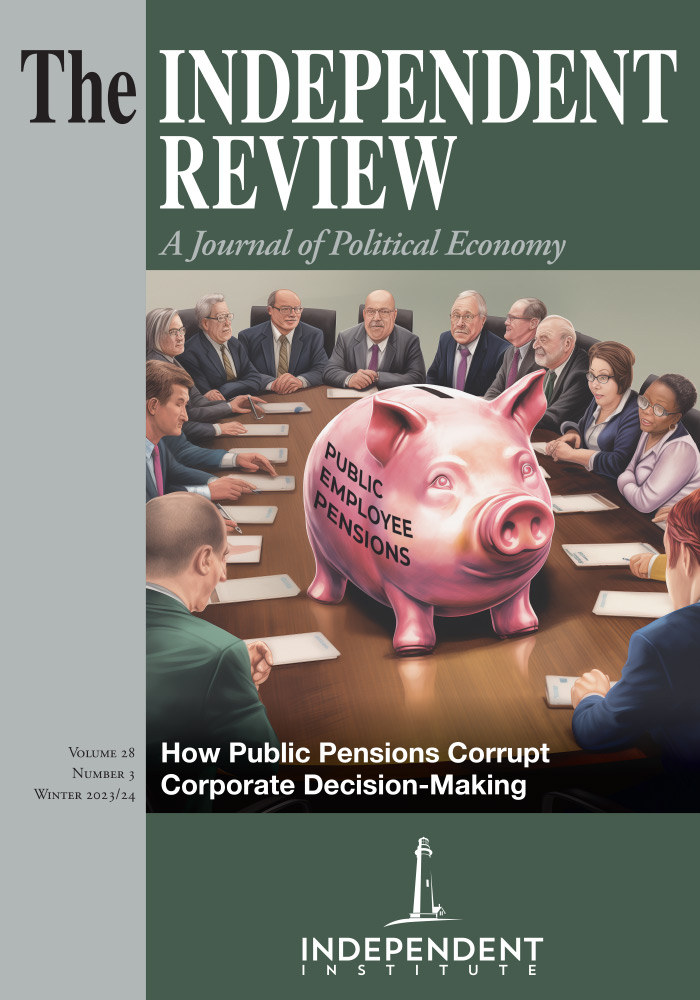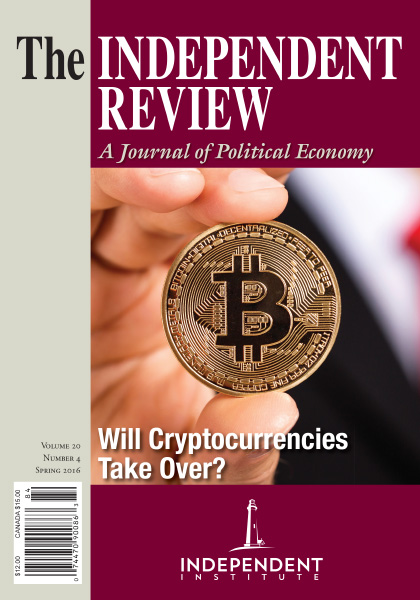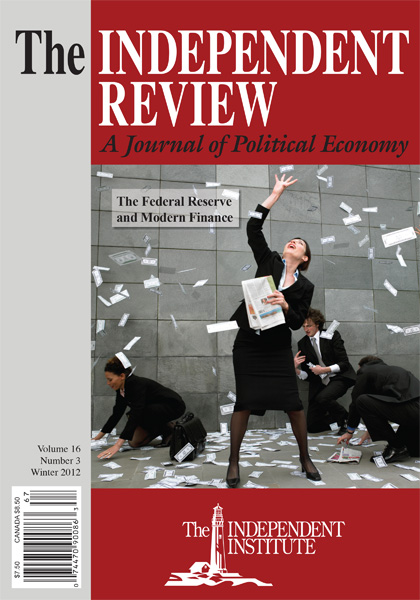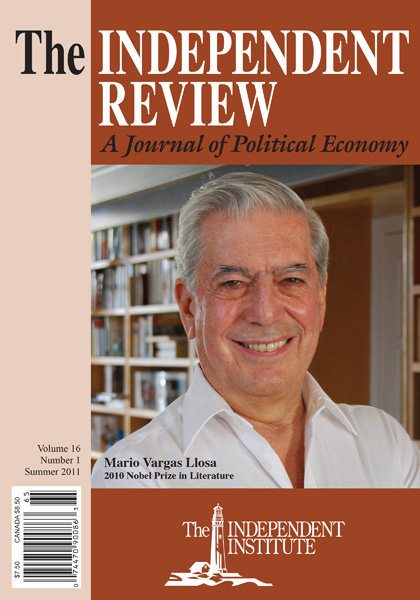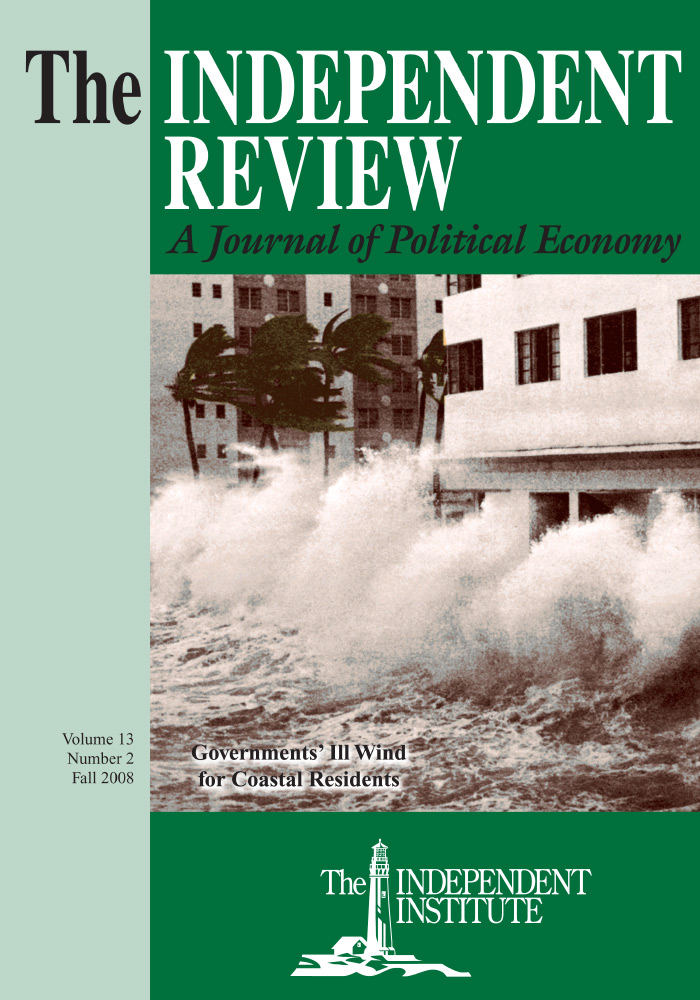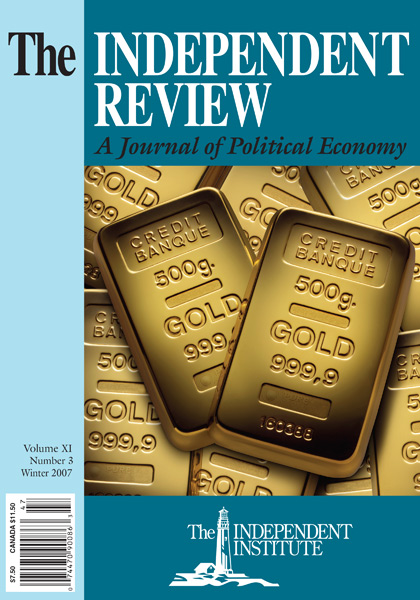“What we are witnessing today is, instead, neither a coup nor a revolution, but a slow metamorphosis from ‘the land of the free and the home of the brave’ to the land of the unfree and the home of the cowardly, whereby citizens themselves accede to the government’s usurpation of their rights.” Readers of The Independent Review will recognize these words from Laurie Calhoun’s excellent essay, “Tyranny Reverse Engineered” (2023, 67).
While the text contains a vast number of valuable insights worth touching upon, it is its central thesis that is most relevant to this article. By drawing on Gene Sharp’s theory of nonviolent resistance, Calhoun shows that the very opposite behavior, complacency in the face of creeping totalitarianism, has led to the America we live in today. A country that seemingly rests on the pillars of its libertarian founding yet has come to accept a status quo of perpetual war for perpetual peace, a permanent garrison state and the obscene military budgets that come with it, extra-judicial drone killings of U.S. citizens in foreign lands, and a government that blatantly censors dissidents, as has become apparent in both its treatment of Julian Assange and the more recent “Twitter Files” revelations.
When Calhoun asks, “how could persons born in a country governed democratically find themselves in the structural equivalent of a military state, which imposes its will tyrannically on citizens through the totalitarian control of information?” (Calhoun 2023, 66), she is, knowingly or unknowingly, echoing the great journalist and author Garet Garrett, who, too, noticed such a revolution when he looked back at the true nature of the New Deal in his iconic 1938 essay “The Revolution Was” (Garrett 1953) In this masterpiece of revisionist history, Garrett analyzes the Roosevelt administration’s policies not on the basis of publicly declared intentions, but through the lens of a revolutionary program. He divides FDR’s makeover of the American political and economic order into nine separate steps, beginning with “Capture the seat of government,” and finally leading up to “Make the government the great capitalist and enterpriser.” In doing so, what he revealed was neither a chaotic sequence of hastily improvised laws nor well-meaning but misguided economic policy, but a carefully planned and flawlessly executed attack on America’s Constitution. Writes Garrett, “it went by in the Night of Depression, singing songs to freedom.” (Garrett 1938 [1953], 15)
Picturing the tragic confusion so common among New Deal skeptics, Garrett draws upon the wisdom of ancient Greece: “There are those that have never ceased to say very earnestly, ‘Something is going to happen to the American form of government if we don’t watch out.’ These were the innocent disarmers. Their trust was in words. They had forgotten their Aristotle. More than 2,000 years ago he wrote of what can happen within the form, when ‘one thing takes the place of another, so that the ancient laws will remain, while the power will be in the hands of those who have brought about revolution in the state’” (Garrett 1953, 15). How could one read these lines, read Calhoun’s essay, and realize that our entire history, all throughout the 85 years that lay between the two texts, has been a constant, never-ending revolution within the form?
We went from the Progressive Era to Woodrow Wilson’s signature under the Federal Reserve Act and his introduction of the income tax, from the New Deal to World War II and everything that followed: the emergence of a military-industrial complex, the CIA, NATO, and a global American empire that would make the Founders turn in their graves. To this our political leaders added the Vietnam War, the Great Society programs, the closing of the gold window in 1971, the rise of the surveillance state, more wars in the Middle East, trillion-dollar deficits, and, lastly, the rise of biopolitics.
It does reveal a great deal about the nature of politics to pose the question how much of this the American people actually asked for. Again, we turn to the chronicler of an America that is no more, Garet Garrett, who wrote in his 1951 essay “Ex America” (Garrett 1953, 92): “They did not vote for getting into World War I. They voted against it. The slogan that elected President Wilson in 1916 was: ‘He kept us out of war.’ Then in a little while we were in it and supporting it fanatically. They did not vote for the New Deal. They voted against it. That is to say, they elected President Mr. Roosevelt on a platform that promised less government, a balanced Federal budget, and sound money. Nevertheless, when it came, they embraced the New Deal, with all its extensions of government authority, its deficit spending and its debasement of the currency.”
He continues:
They did not vote for getting into World War II. So far as they could, they voted against it. Annotating in 1941 the 1939 version of his Public Papers, Mr. Roosevelt wrote: ‘There can be no question that the people of the United States in 1939 were determined to remain neutral in fact and deed.’ They believed him when he said, during the 1940 campaign, ‘again and again and again’ that their sons would never be sent to fight in foreign wars. So, he was elected a third time on his pledge to keep the country out of war. They never voted for the Welfare State, with its distortions of the public debt, its basic socialism, its endless vista of confiscatory taxation, its compulsions and its police-like meddling with their private lives.... Yet step by step they accepted it and liked it” (Garrett 1953, 92-93).
Initial resistance, followed by tacit acceptance, and then, finally, open sympathy for the chains that bind us—this seems to be the psychology that accommodates all of the government’s leaps to our bright, enlightened, unfree future. But if that is so, then how do we resist? How do we not only stop the growth of state power but also roll back and abolish programs that never should have been set up in the first place? How can we fuse intellectual radicalism with the practice of nonviolence in a way that will pose a roadblock for tyranny and restore liberty in this land? What can we do?
Let us go to the drawing board here. It is self-evident that in order to oppose most effectively the growth of state power, one would need to rally around the one ideal that is its polar opposite: individual freedom. While a lot can be said for utilitarian arguments in favor of liberty, the bolder, more principled approach would be its defense on moral grounds. Uncompromising individualism, based on natural law, would become this movement’s intellectual core, its bright flame, its antithesis to the prevailing collectivism of our time. For this strategy would put it in the tradition of St. Thomas Aquinas, John Locke, and last-but-not-least, our Founding Fathers. There does not seem to be a more fitting name for this endeavor than the American Heritage Movement.
In search for an economic foundation, the American Heritage Movement would recognize much of mainstream economics to be thinly disguised apologia for the interventionist state, and instead turn to common sense economics, which is Austrian economics. In doing so, it would recognize the importance of voluntary interactions, understand the harm that is done by government intervention, and subsequently present a vision for a complete separation of state and economy. A special focus would be dedicated to the most harmful of distortions, the government’s malicious influence on the quality of our money.
With its unique fusion of intellectual radicalism and the American tradition, the American Heritage Movement would likely draw in curious, intelligent, and idealistic Americans from all walks of life. Those would then become involved in local politics and assume the role of community stewards in this bottom-up liberty revolution. To stay true to the American Heritage Movement’s founding principles the approach would need to be principled, yet pragmatic. Intrusions of individual freedom would be rejected, the removal of such intrusions supported. Nullification would be seen as the default solution to unconstitutional commands from Washington. To spread awareness of the American Heritage Movement’s goals and motivations, public activism would go hand-in-hand with outreach and education. Should the local State House, for instance, discuss the topic of education freedom, American Heritage Movement members would use their influence to shed light on the wisdom hidden in such classics as James Tooley’s Really Good Schools (2021), or Sheldon Richman’s Separating School and State (1994).
Given the idealism of our imaginary activists, it is even conceivable that an attempt would be made to concentrate these efforts in a specific geographic area, maybe even a single state, which in turn allowed for more rapid progress than would be realistic in larger, more authoritarian states. By consolidating power on such a local level, one would not only form a more dedicated activist base but also build a brand that with its strategy and tactics would serve as a guiding light for all liberty initiatives in the country.
It should be apparent that the American Heritage Movement would neither be a “left” nor “right” phenomenon. Particularly with the latter, local focus, it would defy ordinary political categories and instead revive what is unique and most precious about the American tradition. It would follow in the footsteps of such thinkers as John Taylor Gatto, who in his Underground History of American Education (2017, 50) wrote about post-revolutionary America: “Words can’t adequately convey the stupendous radicalism hidden in our quiet villages, a belief that ordinary people have a right to govern themselves.” It would echo the wisdom of the New Left historian William Appleman Williams, who, just as Gatto, noticed an irreconcilable conflict between the centralization of political power and human flourishing. The economist Murray Rothbard quoted him as saying: “The core radical ideas and values of community, equality, democracy, and humaneness simply cannot in the future be sustained—nor should they be sought—through more centralization and consolidation. These radical values can most nearly be realized through decentralization and through the creation of many truly human communities” (Payne 2005, 14).
One would think that the most pressing question is “How do we get there?” But is it?
How would you react if this American Heritage Movement already existed? If it had not only been founded as a vague idea but already managed to convince close to 10,000 individuals to migrate to a single state and fight for liberty in their lifetime? If those efforts had already produced a unique network of advocacy groups and alliances as well as a thriving community for everyone from new movers to homeschooling families? If it had managed to get its liberty advocates elected to the State House and already constituted the majority within the governing party?
Those are not mere rhetorical phrases. The American Heritage Movement does exist. The crux is that it does not go by that name. It is called the Free State Project and it lives in New Hampshire (see fsp.org).
Since it is, both historically and ideologically, tied to the libertarian movement, it is commonly also looked at through this narrow lens. This is an injustice. It is, as has been elaborated, a movement that is radical yet inclusive, principled yet non-partisan, and which has as its goal to preserve the American legacy of individualism while helping to build a society open to everyone who values nonviolence and human flourishing.
References
Calhoun, Laurie. 2023. “Tyranny Reverse Engineered.” The Independent Review 28, no. 1: 57–70.
Garrett, Garet. 1953. The People’s Pottage. Caldwell, Idaho: Caxton Printers.
Gatto, John Taylor. 2017. The Underground History of American Education: A School Teacher’s Intimate Investigation into the Prison of Modern Schooling. Oxford, N.Y.: Oxford Scholars Press.
Payne, John. 2005. “Rothbard’s Time on the Left.” Journal of Libertarian Studies 19, no. 1: 7–24.
Richman, Sheldon. 1994. Separating School and State: How to Liberate America’s Families. Fairfax, Va.: Future of Freedom Foundation.
Tooley, James. 2021. Really Good Schools: Global Lessons for High-Caliber, Low-Cost Education. Oakland, Calif.: Independent Institute.

